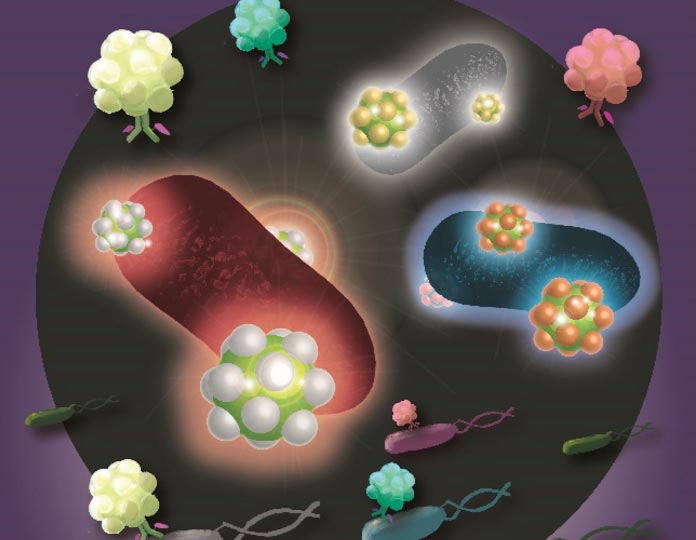White, red, and blue signals alert you to dangerous germs!

Introducing antibodies that specifically bind to bacteria into nanometer-scaled hybrid structures of polymer-coated metal nanoparticles and then using these structures as test labels, OMU scientists successfully detected food poisoning bacteria E. coli O26, E. coli O157, and S. aureus as white, red, and blue scattered light under the microscope.
Credit: Shiigi, Osaka Metropolitan University
Success in rapid and simultaneous identification of multiple types of food poisoning bacteria by color differences in scattered light from metals.
Osaka Metropolitan University scientists have developed a simple, rapid method to simultaneously identify multiple food poisoning bacteria, based on color differences in the scattered light by nanometer-scaled organic metal nanohybrid structures (NHs) that bind via antibodies to those bacteria. This method is a promising tool for rapidly detecting bacteria at food manufacturing sites and thereby improving food safety. The findings were published in Analytical Chemistry.
According to the World Health Organization (WHO), every year food poisoning affects 600 million people worldwide—almost 1 in every 10 people—of which 420,000 die. Bacterial tests are conducted to detect food poisoning bacteria at food manufacturing factories, but it takes more than 48 hours to obtain results due to the time required for a bacteria incubation process called culturing. Therefore, there remains a demand for rapid testing methods to eliminate food poisoning accidents.
Responding to this need, the research team led by Professor Hiroshi Shiigi at the Graduate School of Engineering, Osaka Metropolitan University, utilized the optical properties of organic metal NHs—composites consisting of polyaniline particles that encapsulate a large number of metal nanoparticles—to rapidly and simultaneously identify food poisoning-inducing bacteria called enterohemorrhagic Escherichia coli (E. coli O26 and E. coli O157) and Staphylococcus aureus.
The team first found that organic metal NHs produced stronger scattered light than metal nanoparticles of the same size. Since the scattered light of these NHs is stable in the air for a long period of time, they are expected to function as stable and highly sensitive labeling materials. Furthermore, it has been revealed that these NHs exhibit different colors of scattered light (white, red, and blue) depending on the metal elements of the nanoparticles (gold, silver, and copper).
Then the team introduced antibodies that bind specifically to E. coli O26, E. coli O157, and S. aureus into the organic metal NHs and used these NHs as labels to evaluate the binding properties of the antibody-conjugated NHs to specific bacterial species. As a result, E. coli O26, E. coli O157, and S. aureus were observed as white, red, and blue scattered light, respectively, under the microscope. Furthermore, when adding predetermined amounts of E. coli O26, E. coli O157, and S. aureus to rotten meat samples containing various species of bacteria, the team succeeded in using these labels to simultaneously identify each bacterial species added.
This method can identify various types of bacteria by changing the antibodies to be introduced. In addition, since it does not require culturing, bacteria can be rapidly detected within one hour, increasing its practicality as a new testing method.
Professor Shiigi commented, “We aim to establish new detection principles and testing methods through the development of unique nano-biomaterials. Through this development, we hope to contribute not only to food safety and security, but also to the formation of a safe and affluent society in terms of stable supply and quality control of functional foods, medical care, drug discovery, and public health.”
About OMU
Osaka Metropolitan University is a new public university established by a merger between Osaka City University and Osaka Prefecture University in April 2022. For more science news, see https://www.upc-osaka.ac.jp/new-univ/en-research/, and follow @OsakaMetUniv_en, or search #OMUScience
Journal: Analytical Chemistry
DOI: 10.1021/acs.analchem.2c01188
Method of Research: Experimental study
Article Title: Simultaneous Optical Detection of Multiple Bacterial Species Using Nanometer- Scaled Metal−Organic Hybrids
Article Publication Date: 25-Jul-2022
Media Contact
Ngoc Han Hoang
Osaka Metropolitan University
koho-ipro@ml.omu.ac.jp
Original Source
All latest news from the category: Life Sciences and Chemistry
Articles and reports from the Life Sciences and chemistry area deal with applied and basic research into modern biology, chemistry and human medicine.
Valuable information can be found on a range of life sciences fields including bacteriology, biochemistry, bionics, bioinformatics, biophysics, biotechnology, genetics, geobotany, human biology, marine biology, microbiology, molecular biology, cellular biology, zoology, bioinorganic chemistry, microchemistry and environmental chemistry.
Newest articles

Innovative 3D printed scaffolds offer new hope for bone healing
Researchers at the Institute for Bioengineering of Catalonia have developed novel 3D printed PLA-CaP scaffolds that promote blood vessel formation, ensuring better healing and regeneration of bone tissue. Bone is…

The surprising role of gut infection in Alzheimer’s disease
ASU- and Banner Alzheimer’s Institute-led study implicates link between a common virus and the disease, which travels from the gut to the brain and may be a target for antiviral…

Molecular gardening: New enzymes discovered for protein modification pruning
How deubiquitinases USP53 and USP54 cleave long polyubiquitin chains and how the former is linked to liver disease in children. Deubiquitinases (DUBs) are enzymes used by cells to trim protein…



